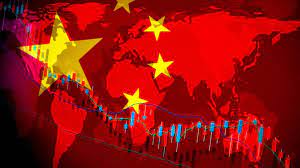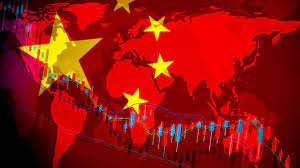
China's central bank confronts a significant challenge in combating the prospect of deflation: more credit is moving to productive forces rather than consumption, exposing fundamental faults in the economy and decreasing the effectiveness of its monetary policy tools.
The People's Bank of China (PBOC) is under pressure to lower interest rates since decreasing prices increase the real borrowing costs for private enterprises and people, reducing investment, hiring, and consumer spending.
The deteriorating asset quality caused by the property crisis and local government debt issues is also putting pressure on central bankers to infuse liquidity into the banking system by lowering reserve requirements in order to avoid a funding crunch.
However, both approaches share a fundamental problem: credit demand in China is mostly driven by the manufacturing and infrastructure sectors, where overcapacity difficulties are increasing the economy's deflationary tendencies.
Beijing has been shifting money flows from its struggling real estate industry to manufacturing in an effort to propel its sectors up the value chain. For decades, infrastructure spending has been the primary driver of China's high investment rates, diverting economic resources away from individuals.
"Much of the credit is going to the infrastructure sector and also into some of the excess capacity," said Hong Hao, chief economist at Grow Investment Group. "That way, it actually creates further deflationary pressures. That's the problem."
The People's Bank of China (PBOC) "will continue to ease, but I think monetary policy at this juncture is less effective than it should be," he told reporters.
Analysts believe the PBOC's predicament highlights the need for the government to accelerate structural reforms to stimulate consumption, a long-standing gap in policies that it has promised to address through 2023 but has yet to make substantial progress on.
China's consumer prices decreased by 0.5% year on year in November, the fastest in three years, while factory-gate prices plummeted by a stunning 3.0%, highlighting the weakness of both external and domestic demand in relation to production capacity.
December inflation data is anticipated on Friday, and the PBOC may decide its next move on the benchmark rate on January 22.
A prolonged period of declining prices may discourage additional private sector investment and consumer spending, so harming jobs and wages and becoming a self-feeding mechanism that drags on growth, as observed in Japan in the 1990s.
China's money supply reflects the weak private sector demand for loans.
In November, the ratio of M1 money supply (cash in circulation and corporate demand deposits) to M2 money supply (fixed corporate, household, and other deposits) reached a new low.
"Low M1 growth could be an indicator of weak private business confidence, or a byproduct of the property downturn, or both, suggesting less satisfactory policy transmission. This is really concerning," Citi analysts wrote.
Approximately 20% of the 21.58 trillion yuan ($3.01 trillion) in new loans provided between January and November 2023 went to households, with business loans accounting for the remainder.
Analysts believe the majority of those loans were taken out by state-owned firms, which often have access to cheaper financing from state banks.
Private enterprises, particularly those operating in industries that are not considered national objectives, have additional challenges.
The PBOC's benchmark one-year loan prime rate (LPR) is 3.45%, the lowest since August 2019, following many rate reduction in recent years. When corrected for factory-gate prices, however, the rate has really risen: at 6.45% in November, it is below a multi-year high of 8.95% in June, but still above China's predicted GDP growth for 2023 of approximately 5%.
While economists argue that structural imbalances need the PBOC to take modest moves, rising real borrowing costs suggest that additional monetary easing is not without value.
On December 22, five of China's top state banks slashed interest rates on select deposits, perhaps paving the path for the PBOC to lower policy rates as early as this month.
Citi anticipates a total of 20 basis points (bps) in policy rate decreases and a 50-bps fall in banks' reserve requirement ratios (RRR) this year. Goldman Sachs forecasts three 25-bps RRR reduction and one 10-bps policy rate cut.
Tommy Xie, head of Greater China research at OCBC Bank, cautioned that additional liquidity injections could exacerbate deflationary pressures in the present monetary, fiscal, and other policies.
"The focus of stimulus measures appears predominantly on the supply side," Xie said.
"By bolstering production, these policies have played a crucial role in maintaining job stability. However, this increase in production has encountered a sluggish demand environment, heightening the risk of disinflation."
In a November address in Hong Kong, central bank governor Pan Gongsheng promised to keep monetary policy "accommodative," but he also called for measures to reduce the economy's reliance on infrastructure and real estate.
"What's needed to stave off the risk of greater disinflation is stronger demand and economic growth," said Frederic Neumann, chief Asia economist at HSBC.
"To achieve this, it's best to make use of not just monetary easing, but implement supportive fiscal policy and structural reforms as well."
(Source:www.usnews.com)
The People's Bank of China (PBOC) is under pressure to lower interest rates since decreasing prices increase the real borrowing costs for private enterprises and people, reducing investment, hiring, and consumer spending.
The deteriorating asset quality caused by the property crisis and local government debt issues is also putting pressure on central bankers to infuse liquidity into the banking system by lowering reserve requirements in order to avoid a funding crunch.
However, both approaches share a fundamental problem: credit demand in China is mostly driven by the manufacturing and infrastructure sectors, where overcapacity difficulties are increasing the economy's deflationary tendencies.
Beijing has been shifting money flows from its struggling real estate industry to manufacturing in an effort to propel its sectors up the value chain. For decades, infrastructure spending has been the primary driver of China's high investment rates, diverting economic resources away from individuals.
"Much of the credit is going to the infrastructure sector and also into some of the excess capacity," said Hong Hao, chief economist at Grow Investment Group. "That way, it actually creates further deflationary pressures. That's the problem."
The People's Bank of China (PBOC) "will continue to ease, but I think monetary policy at this juncture is less effective than it should be," he told reporters.
Analysts believe the PBOC's predicament highlights the need for the government to accelerate structural reforms to stimulate consumption, a long-standing gap in policies that it has promised to address through 2023 but has yet to make substantial progress on.
China's consumer prices decreased by 0.5% year on year in November, the fastest in three years, while factory-gate prices plummeted by a stunning 3.0%, highlighting the weakness of both external and domestic demand in relation to production capacity.
December inflation data is anticipated on Friday, and the PBOC may decide its next move on the benchmark rate on January 22.
A prolonged period of declining prices may discourage additional private sector investment and consumer spending, so harming jobs and wages and becoming a self-feeding mechanism that drags on growth, as observed in Japan in the 1990s.
China's money supply reflects the weak private sector demand for loans.
In November, the ratio of M1 money supply (cash in circulation and corporate demand deposits) to M2 money supply (fixed corporate, household, and other deposits) reached a new low.
"Low M1 growth could be an indicator of weak private business confidence, or a byproduct of the property downturn, or both, suggesting less satisfactory policy transmission. This is really concerning," Citi analysts wrote.
Approximately 20% of the 21.58 trillion yuan ($3.01 trillion) in new loans provided between January and November 2023 went to households, with business loans accounting for the remainder.
Analysts believe the majority of those loans were taken out by state-owned firms, which often have access to cheaper financing from state banks.
Private enterprises, particularly those operating in industries that are not considered national objectives, have additional challenges.
The PBOC's benchmark one-year loan prime rate (LPR) is 3.45%, the lowest since August 2019, following many rate reduction in recent years. When corrected for factory-gate prices, however, the rate has really risen: at 6.45% in November, it is below a multi-year high of 8.95% in June, but still above China's predicted GDP growth for 2023 of approximately 5%.
While economists argue that structural imbalances need the PBOC to take modest moves, rising real borrowing costs suggest that additional monetary easing is not without value.
On December 22, five of China's top state banks slashed interest rates on select deposits, perhaps paving the path for the PBOC to lower policy rates as early as this month.
Citi anticipates a total of 20 basis points (bps) in policy rate decreases and a 50-bps fall in banks' reserve requirement ratios (RRR) this year. Goldman Sachs forecasts three 25-bps RRR reduction and one 10-bps policy rate cut.
Tommy Xie, head of Greater China research at OCBC Bank, cautioned that additional liquidity injections could exacerbate deflationary pressures in the present monetary, fiscal, and other policies.
"The focus of stimulus measures appears predominantly on the supply side," Xie said.
"By bolstering production, these policies have played a crucial role in maintaining job stability. However, this increase in production has encountered a sluggish demand environment, heightening the risk of disinflation."
In a November address in Hong Kong, central bank governor Pan Gongsheng promised to keep monetary policy "accommodative," but he also called for measures to reduce the economy's reliance on infrastructure and real estate.
"What's needed to stave off the risk of greater disinflation is stronger demand and economic growth," said Frederic Neumann, chief Asia economist at HSBC.
"To achieve this, it's best to make use of not just monetary easing, but implement supportive fiscal policy and structural reforms as well."
(Source:www.usnews.com)





